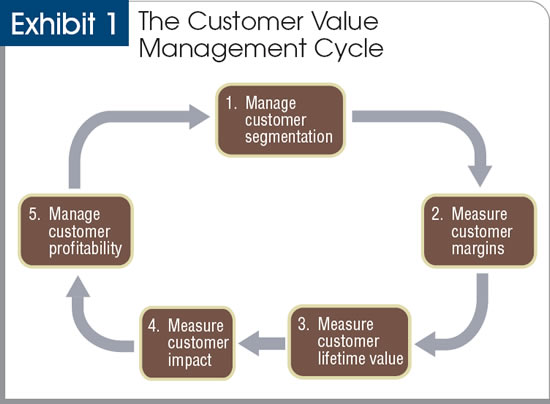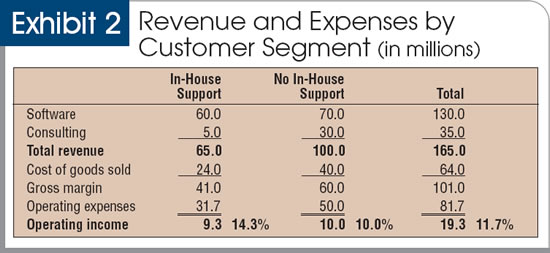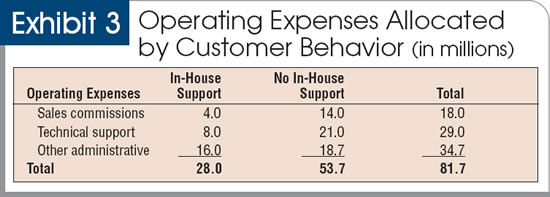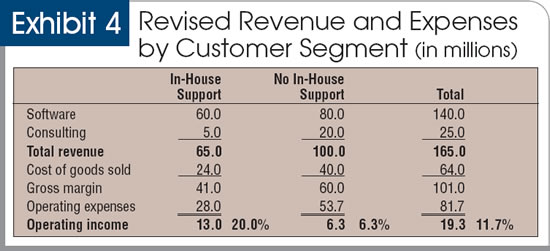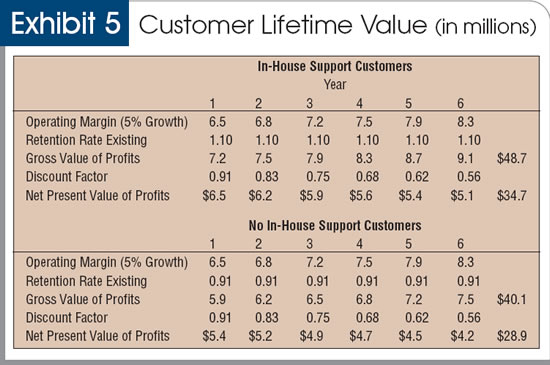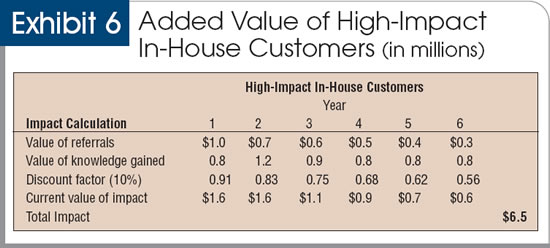- feature
- BUSINESS & INDUSTRY
Managing Customer Profitability
Determine which customers are most valuable to your organizaton.
Please note: This item is from our archives and was published in 2008. It is provided for historical reference. The content may be out of date and links may no longer function.
Related
Summing up economic sentiment and concerns about inflation and tariffs
Business outlook brightens somewhat despite trade, inflation concerns
AICPA & CIMA Business Resilience Toolkit — levers for action
All people may be created equal, but the same can’t be said for customers. Everyone knows that some customers are more profitable than others. Conversely, some are downright unprofitable. Knowing which is which is the all-important question.
Despite enormous variations in profitability, many companies continue unprofitable relationships with customers, often providing them with pricing and service levels identical to those received by the most profitable ones. Why? In most cases, companies simply do not know who the unprofitable customers are. As such, they cannot develop marketing strategies or manage costs accordingly
Companies don’t necessarily need a state-of-the-art database or analytics technology to improve customer profitability. Rather, they can follow a comprehensive approach for measuring and managing customer value called the customer value management cycle (see Exhibit 1). Because of their unique qualifications and abilities, financial managers should take the lead in translating analysis to action and creating the culture of value.
The customer value management cycle has five recurring steps.
To demonstrate the concepts throughout this article, the customer value management cycle is applied to a fictitious company called Sagu Systems. A brief description of Sagu Systems is as follows:
Sagu is a software company located in Chicago. Its primary product, SaguNetwork, is performance monitoring software for corporate networks. Sagu currently sells SaguNetwork and related consulting services to clients. The market for performance management software is expanding rapidly, and Sagu is pursuing an aggressive growth strategy. In an effort to maintain profitability through the growth period, the board of directors has mandated that Sagu analyze the profitability of its customers.
STEP 1: MANAGE CUSTOMER SEGMENTATION
Customer segmentation refers to the process of dividing customers into groups for decision-making purposes. Segmentation allows the company to provide differential advertising or value propositions to different customer groups. Segments are often determined on the basis of customer similarities, such as personal characteristics, preferences or behaviors. Ideally, segments should correlate to behaviors that drive customer profitability
Segments are continually redefined as the process repeats and customer understanding is refined. For many companies, segments support marketing. Customers can be grouped based on marketing-related characteristics such as expected responses to advertisements or expected purchasing behavior. As companies move toward rigorous measurement and analysis of customer profitability, they may refine segments as they discover new segmentation parameters.
In the Sagu example, the company begins by analyzing current customers and their purchasing patterns. The analysis results in the two customer segments (see Exhibit 2):
- In-House Support: customers with in-house IT staff capable of supporting the software
- No In-House Support: customers lacking in-house IT staff capable of supporting the software
In steps 2, 3 and 4, Sagu calculates the current and expected future value contributions for each segment. In Step 5, Sagu uses the results of this analysis to revise the management of customer value in each segment.
Finally, Sagu returns to Step 1 and restarts the cycle—resegmenting customers based on profitability-related behaviors.
STEP 2: MEASURE CUSTOMER SEGMENT MARGINS
Although almost all companies have processes for assessing the profitability of their products, most are far behind in assessing their customers’ profitability. Some customers are highly profitable, some are moderately profitable, and some are unprofitable. Many people believe that the 80-20 rule can be applied to customers, which suggests that 20% of the customers are responsible for 80% of the profits. However, results for many companies have been far more extreme.
At a minimum, companies should measure revenue and gross profit by each customer segment. Allocating sales, marketing and customer service costs brings this analysis to the next level. Selling costs in many organizations vary significantly between customers and segments. Simple changes in the sales compensation plan that more highly rewards profitable deals than lessprofitable ones can improve overall profitability.
Invoicing, credit and collection costs might also vary significantly. Changes to pricing and terms tailored to certain segments will also improve profitability.
To be effective, each company should look at the highest-cost line items and determine whether there is a reasonable basis under which to allocate the costs to customers or segments.
Sagu has historically allocated operating expenses based on total revenue of the segment. However, Sagu realizes that operating costs vary across segments as a result of different customer behaviors within the segments. In particular, sales commission costs are associated with software and consulting sales, and technical support costs are associated with the number of maintenance requests submitted by a customer. Sagu separates these costs from other operating expenses and assigns them to the segments based on the actual commissions awarded and technical requests made by each segment. Results are shown in Exhibit 3. Segment profits calculated using the new operating expense numbers are shown in Exhibit 4.
STEP 3: MEASURE CUSTOMER LIFETIME VALUE
“Customer lifetime value” (CLV) introduces a new dimension to understanding the value a customer provides. Margin-based calculations focus on the profits realized in the current period as a result of customer purchases. CLV takes a different approach. It treats customers as corporate assets. Companies that use CLV recognize that the costs of attracting a customer represent an investment. They also recognize that the investment can be expected to produce additional future income over time. The lifetime value of the customer reflects the net present value of all expected cash flows associated with the customer.
Companies that use CLV recognize that a customer’s profitability in one period isn’t necessarily predictive of profitability in other periods, since revenues and costs can vary significantly over time. Thus, CLV values customers on the basis of their expected income-generating potential, rather than solely on their past behavior.
Typically, the customer relationship begins when the company invests to attract the customer. As the relationship matures, the customer’s sales volume may grow and become more profitable. This accumulation should accelerate over time for two reasons. First, the cost to serve the customer should decrease as a percentage of revenues because the customer’s knowledge of the company and its products, together with increasing trust, may lead to reductions in promotion, training and relationship maintenance costs. Second, as the relationship matures, the customer may be more likely to respond to cross-selling or upselling initiatives
Thus, by expanding the notion of profitability to incorporate profits over the entire lifetime of the customer relationship, marketers have significantly enhanced their ability to effectively manage customers for enhanced profitability. Calculating CLV requires an understanding of customer retention rates in addition to purchasing patterns and costs for each segment, then discounting the values to the present. Simply put, CLV is the present value of profits over the expected lifetime of the customer or segment
This analysis can significantly affect a company’s view of a segment with small initial purchases but with a long expected relationship, versus a segment with a larger initial purchase but limited repeat potential.
Sagu, for example, armed with information about current profitability, can begin to assess the long-term value of each customer segment. To do this, the company will estimate growth in profits for each segment and change in size of each segment as Sagu loses old customers and adds new ones over time. Exhibit 5 shows the CLV calculations for its In-House Support and No In-House Support customer segments during the coming six years. CLV shows the value of a segment’s customers to Sagu today, based on the discounted value of anticipated future profits. To simplify the example, it is assumed that the operating margins of both segments are equal in year one. Income growth and retention rates are held constant over the six-year period.
Sagu’s CLV analysis provides a new perspective on the relative value of these customer segments. The In-House Support segment is expected to grow at a 10% rate, as a result of additions in software users to existing software packages. Discounting each year’s anticipated profits back to the present using a 10% rate results in an expected lifetime value for the segment of $34.7 million. The CLV analysis tells a different story about the relative value of the No In-House Support segment. The No In-House Support segment shows a loss of market size, due to a low customer retention rate, and a correspondingly lower lifetime value as a result of this attrition.
STEP 4: MEASURE CUSTOMER IMPACT
The final component of value provided by the customer is customer impact. Activity-based costing and customer lifetime value have enabled companies to make great advances in understanding the expected profitability of their customers. They can provide excellent estimates of the value that each customer and segment provides to the company through normal purchasing and usage.
But these approaches often fail to capture some potentially significant sources of value customers can provide to the company. Of course, profits resulting from current or future sales to customers are the most significant source of value for most customer segments. But value can be created (or destroyed) by customers in many other ways that fall outside the reach of CLV.
Two critical sources of hidden customer value are customer influence and customer knowledge. Customer influence refers to the influence the customer has, either through intentional action or passive behavior, on other customers, on employees, or on other stakeholders of the firm. Customer knowledge refers to the actionable knowledge that can be gained by the company, either through analyzing customer behavior or through direct customer input. Through their interactions with the product, with the company and with other stakeholders, customers can affect value in numerous ways, ranging from identifying small errors in technical documentation to significantly influencing the brand’s image.
Although influence and knowledge contributions will always be difficult to define and measure, even rudimentary estimates of direction and magnitude can be valuable. To ignore such contributions is akin to assigning them a value of $0, which is certainly incorrect, and may rob the company of the opportunity to investigate these increasingly important aspects of customer value.
Over time, companies that think creatively about a full range of sources of customer value gradually improve their understanding of these sources, and their ability to assess and measure them. Embarking on this process opens new avenues for innovation in products and methods, and generates new options for maximizing long-term customer value.
For Sagu to supplement its CLV analysis, the company estimates the potential impact of each customer segment. Through this analysis, Sagu realizes that a small number of its large clients in the In-House Support segment generate half the revenue of this segment, and virtually all of the customer impact. These loyal clients are very well-known and highly respected in the software industry. Sagu estimates that they are responsible for a significant portion of the client growth that contributes to favorable retention rates—both through reputation and through referrals. In addition, these customers are very knowledgeable, and are used as testing sites for new software enhancements and sounding boards for technical planning personnel.
The estimated benefits in this scenario include: (1) influencing/referring other customers and (2) testing and improving software prior to release. The sum of the discounted values of these benefits is expected to be $6.5 million, as shown in Exhibit 6.
STEP 5: MANAGE CUSTOMER PROFITABILITY
This is where the proverbial rubber meets the road. All of the information derived from the measurement of customer value should be analyzed, and actionable tidbits should be derived. This goes far beyond simple reporting of which segments have been more or less profitable. Innovative segmentation and interpretation of the results can uncover areas where small improvements can yield big improvements in value. For example:
- A segment where technical support costs are disproportionate could drive improved documentation.
- Segments with lower expected customer life could reveal a lack of attention from the customer service team.
- A segment with high revenues but low profits might indicate the need to retool the sales compensation scheme to shift incentives to increase focus on profits.
Sagu has learned a great deal about the profitability of its segments through this analysis and will use this information to more effectively manage the value of these segments. First, through the Step 2 analysis of customer margins, Sagu has learned that the No In-House Support segment has higher operating costs than were apparent under the former cost allocation system. In part, this was the result of high maintenance costs for these clients.
To address this issue, Sagu decided to change the maintenance agreement it provides to customers. In the future, customers will be provided with a limited number of technical support hours and will be charged for any additional time.
Through the CLV analysis in Step 3, Sagu learned that the No In-House Support segment was expected to show profitability losses over time, due to low profitability growth and retention rates over time.
As a result of this analysis, Sagu interviewed key clients in the segment to determine reasons for the decline. These clients suggested that they needed additional consulting support to help them make the best use of their software. Sagu has increased efforts to inform customers about available consulting services, and anticipates both growth in consulting revenues and increased retention in the segment as a result.
Finally, in Step 5, Sagu analyzed customer impact and realized that the customers with the greatest impact on both attracting new customers and on gaining valuable knowledge were a subset of their In-House Customers. This group of clients consists of highly knowledgeable users, who contribute product and service knowledge to Sagu, and also encourage other clients to adopt the software—either through direct referrals or through reputation.
Through the customer impact analysis, Sagu has recognized the high value of these customers to the firm and has initiated new policies designed to provide special benefits to these customers. They will receive a discounted rate for adding software seats, which is expected to grow profits more rapidly and strengthen customer loyalty. And they will be invited to sit on a newly formed user advisory board, which will provide them with some prestige and the opportunity to interact directly with other high-powered users to share insights and strategies with each other and with Sagu.
CONCLUSION
By measuring the profitability of segments and managing customer relationships based on customer value, both the customer and company win. Orienting an organization around measurement and management of customer profitability can take place immediately, or it can take many periods, implementing these strategies one step at a time, and adjusting and refining along the way. Over time a company will gain invaluable knowledge and be able to put it to work for the mutual benefit of all stakeholders. 
AICPA RESOURCES
Management Accounting Guidelines
l Managing Customer Value
l Managing Opportunities and Risks
l Impacting Future Value: How to Manage your Intellectual Capital
AICPA members can download all Management Accounting Guidelines for free here.
Business, Industry & Government
For more information and resources in business, industry and government, please visit the Financial Management Center at www.aicpa.org/fmcenter.
EXECUTIVE SUMMARY

The customer value management cycle presents a comprehensive model for measuring and managing customer value—it has five recurring steps.

Step 1: Manage Customer Segmentation. Customer segmentation refers to the process of dividing customers into groups for decision-making purposes. Segments should correlate to behaviors that drive customer profitability.

Step 2: Measure Customer Segment Margins. At a minimum, companies should measure revenue and gross profit by each customer segment. Allocating sales, marketing and customer service costs brings this analysis to the next level.

Step 3: Measure Customer Lifetime Value. The lifetime value of the customer reflects the present value of all expected future flows associated with the customer.

Step 4: Measure Customer Impact. Two critical sources of hidden customer value are customer influence and customer knowledge. Customer influence refers to the influence the customer has, either through intentional action or passive behavior, on other customers, on employees, or on other stakeholders of the firm. Customer knowledge refers to the actionable knowledge that can be gained by the company, either through analysis of customer behavior or through direct customer input.

Step 5: Manage Customer Profitability. All of the information derived from the measurement of customer value should be analyzed, and actionable tidbits should be derived. This goes far beyond simple reporting of which segments have been more or less profitable. Innovative segmentation and interpretation of the results can uncover areas where small improvements can yield big improvements in value.
Marc J. Epstein is a professor of management at Rice University in Houston. Michael Friedl is CFO at Crestwood Pacific Group in Newport Beach, Calif. Kristi Yuthas is the information systems management chair at Portland State University. Their e-mail addresses are epstein@rice.edu, michael.friedl@sbi-usa.com and yuthas@pdx.edu, respectively. This article has been adapted from the Management Accounting Guideline Managing Customer Value by Marc J. Epstein and Kristi Yuthas.

